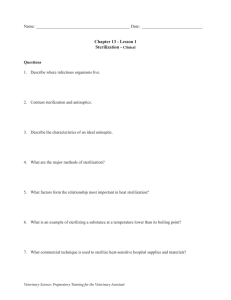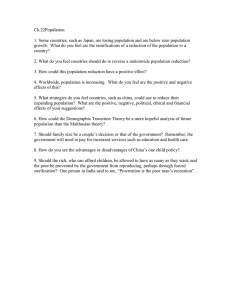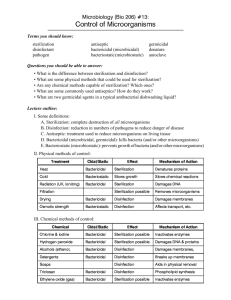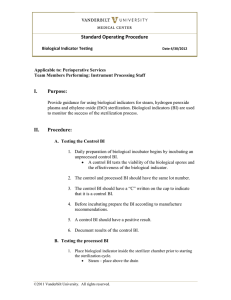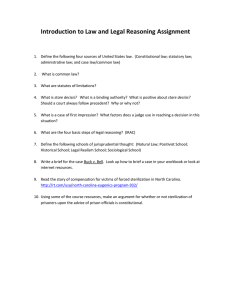Managing manufacturers` instructions
advertisement
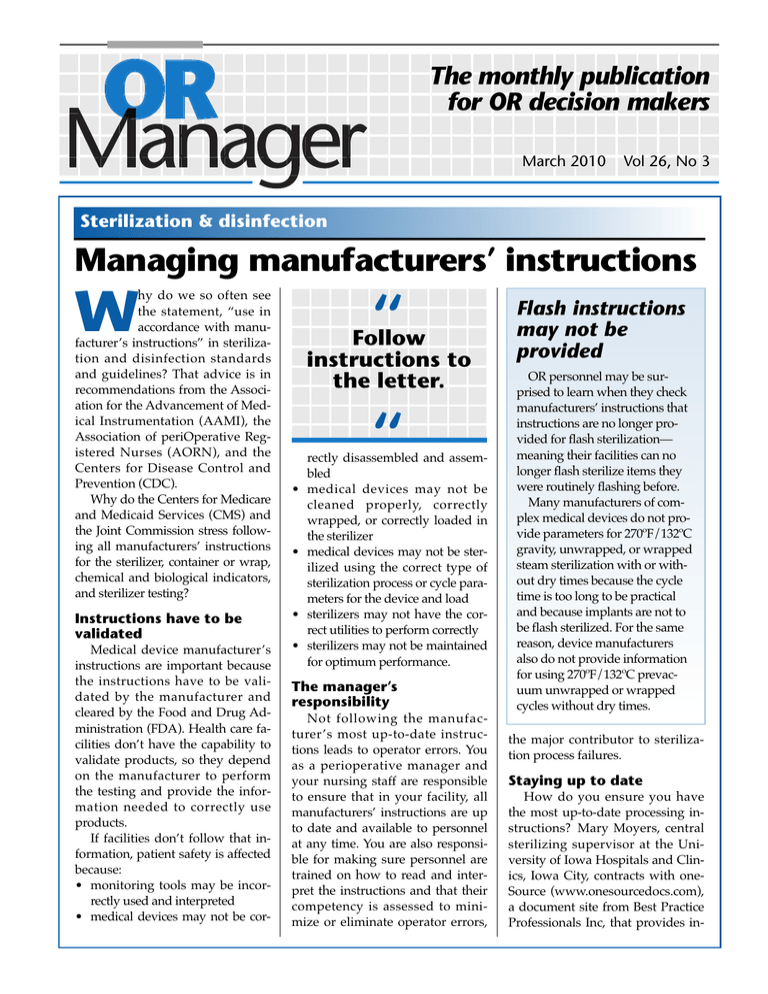
The monthly publication for OR decision makers March 2010 Vol 26, No 3 Sterilization & disinfection Managing manufacturers’ instructions hy do we so often see the statement, “use in accordance with manufacturer’s instructions” in sterilization and disinfection standards and guidelines? That advice is in recommendations from the Association for the Advancement of Medical Instrumentation (AAMI), the Association of periOperative Registered Nurses (AORN), and the Centers for Disease Control and Prevention (CDC). Why do the Centers for Medicare and Medicaid Services (CMS) and the Joint Commission stress following all manufacturers’ instructions for the sterilizer, container or wrap, chemical and biological indicators, and sterilizer testing? W Instructions have to be validated Medical device manufacturer’s instructions are important because the instructions have to be validated by the manufacturer and cleared by the Food and Drug Administration (FDA). Health care facilities don’t have the capability to validate products, so they depend on the manufacturer to perform the testing and provide the information needed to correctly use products. If facilities don’t follow that information, patient safety is affected because: • monitoring tools may be incorrectly used and interpreted • medical devices may not be cor- “ Follow instructions to the letter. • • • • “ rectly disassembled and assembled medical devices may not be cleaned properly, correctly wrapped, or correctly loaded in the sterilizer medical devices may not be sterilized using the correct type of sterilization process or cycle parameters for the device and load sterilizers may not have the correct utilities to perform correctly sterilizers may not be maintained for optimum performance. The manager’s responsibility Not following the manufacturer ’s most up-to-date instructions leads to operator errors. You as a perioperative manager and your nursing staff are responsible to ensure that in your facility, all manufacturers’ instructions are up to date and available to personnel at any time. You are also responsible for making sure personnel are trained on how to read and interpret the instructions and that their competency is assessed to minimize or eliminate operator errors, Flash instructions may not be provided OR personnel may be surprised to learn when they check manufacturers’ instructions that instructions are no longer provided for flash sterilization— meaning their facilities can no longer flash sterilize items they were routinely flashing before. Many manufacturers of complex medical devices do not provide parameters for 270ºF/132ºC gravity, unwrapped, or wrapped steam sterilization with or without dry times because the cycle time is too long to be practical and because implants are not to be flash sterilized. For the same reason, device manufacturers also do not provide information for using 270ºF/132ºC prevacuum unwrapped or wrapped cycles without dry times. the major contributor to sterilization process failures. Staying up to date How do you ensure you have the most up-to-date processing instructions? Mary Moyers, central sterilizing supervisor at the University of Iowa Hospitals and Clinics, Iowa City, contracts with oneSource (www.onesourcedocs.com), a document site from Best Practice Professionals Inc, that provides in- Sterilization & disinfection structions from many manufacturers. Her organization decided to use this service to comply with the Joint Commission’s 2009 update on steam sterilization, which stresses the importance of following up-todate manufacturer’s instructions. When new instructions are available through the oneSource website, the University of Iowa downloads the instructions and changes the information in its electronic tracking system. The system’s barcode scanning feature ensures the instruments are run in the updated sterilization cycle by emitting a warning sound if the operator enters an outdated cycle into the tracking system. Subscriptions to www.onesourcedocs.com have a base price of $2,340/year. You can request that oneSource contact a manufacturer for instructions not available on the site. Instructions are reviewed every 90 days and updated if the manufacturer has changed the information. Tracking instructions Nancy Chobin, RN, sterile processing educator at Saint Barnabas Health Care System, West Orange, New Jersey, says her organization has a corporate policy that requires manufacturers to provide instructions whenever a new device is purchased or reordered. For existing medical devices, the sterile processing manager or delegate is required to check with the manufacturer every 1 to 2 years to obtain updates. All instructions are in 2 separate binders, one in decontamination and one in prep/sterilization. If the instructions are different than the existing ones in the department, policies and procedures are updated, and a notice is posted to alert the staff. Staff is still re2 What’s behind extended cycles? Some medical device manufacturers who provide instruments in a containment system that needs to be wrapped may require a sterilization cycle longer than the cycle validated and recommended by the device manufacturer in the past. The cycle may also be longer than any of the sterilizer manufacturer’s recommended sterilization cycles. These are called extended cycles. An example of an extended cycle is 10 minutes at 270ºF/132ºC in a prevacuum steam sterilizer. How extended cycles came about Extended cycles came about because of a 1996 FDA document entitled “Labeling reusable medical devices for reprocessing in health care facilities: FDA reviewer guidance,” which required changes in the placement of spores for validation testing. During this testing, Geobacillus stearothermophilus spores are typically placed inside areas that create challenges to air removal, such as quired to check reference books before processing a medical device. The same process is used to inform staff of changes in monitoring products, detergents, disinfectants, packaging, and so forth. Be sure instructions are followed Once you obtain the most up-todate instructions, ensure the instructions are followed. These are some changes that would not be validated by the medical device manufacturer and should not be made unless they are part of the instructions: • adding or removing instruments from the original provided container OR Manager Vol 26, No 3 lumens, crevices, and other small interior features of instruments that could harbor residual infectious material. Because this change in testing is a greater challenge, some devices required a longer cycle. This validation testing is a greater challenge than the product testing done by a health care facility. Product testing is not a validation test to determine what the sterilization cycle should be. Rather it is a verification test to determine if the facility’s sterilization process is effective when following medical device manufacturer’s recommended sterilization cycle parameters. Concern about prion contamination is also a cause for extended steam sterilization cycles. Some medical device manufacturers are retesting and validating reduced sterilization times that match the cycles recommended by the sterilizer manufacturer. • removing the instruments from their original packaging and placing them in a rigid container or in any other kind of sterilization container or packaging • adding any foam, towel, or other material to the original provided container • running sterilization parameters different than what is recommended. Regarding extended cycles, only medical devices validated for the extended cycle should go into the sterilizer set or load for an extended cycle or exposure time. If a longer sterilization time is not validated for an instrument, processing it in an extended cycle could March 2010 Sterilization & disinfection reduce its functionality and use life. Has the device been validated? Ask the device manufacturer if the device has been validated for your sterilizers. For example, the manufacturer’s instructions may state testing was performed in a 4-pulse 270°-275ºF (132°-135ºC) prevacuum sterilizer. Ask if that device can be sterilized in a 3-pulse prevacuum sterilizer if that is what you have. Follow to the letter Not only do you need to obtain the up-to-date manufacturers’ in- structions, but you also need to follow them to the letter with no exceptions. Otherwise, you risk providing a patient with a medical device that is not properly sterilized. If the instructions do not provide complete information to properly clean and sterilize a medical device, patient safety may also be affected, and a decision needs to be made about whether to use the device in the future. v —Martha Young, MS, CSPDT President, SAVVY Sterilization Solutions for Healthcare Woodbury, Minnesota Martha Young is an independent consultant with long experience in medical device sterilization and disinfection. References Centers for Medicare and Medicaid Services. Flash Sterilization Clarification: FY 2010 Ambulatory Surgical Center (ASC) Surveys. S&C-09-55. September 4, 2009. www.cms.hhs.gov/Survey CertificationGenInfo/ downloads/SCLetter09_55.pdf Joint Commission. Update: The Joint Commission’s position on steam sterilization. Joint Commission Perspectives. July 2009; 29(7):8, 11. www.jcrinc.com/ common/ PDFs/fpdfs/pubs/ pdfs/JCReqs/JCP-07-09-S8.pdf OR Manager Reprint Copyright © 2010 OR Manager, Inc. P O Box 5303 Santa Fe, NM 87502-5303 Telephone: 800/442-9918 Fax: 505/983-0790 info@ormanager.com March 2010 OR Manager Vol 26, No 3 3
